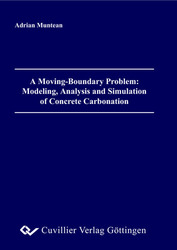| Departments | |
|---|---|
| Book Series (96) |
1378
|
| Nachhaltigkeit |
3
|
| Gesundheitswesen |
1
|
| Humanities |
2364
|
| Natural Sciences |
5406
|
| Mathematics | 229 |
| Informatics | 319 |
| Physics | 980 |
| Chemistry | 1363 |
| Geosciences | 131 |
| Human medicine | 243 |
| Stomatology | 10 |
| Veterinary medicine | 108 |
| Pharmacy | 147 |
| Biology | 835 |
| Biochemistry, molecular biology, gene technology | 121 |
| Biophysics | 25 |
| Domestic and nutritional science | 45 |
| Agricultural science | 1004 |
| Forest science | 201 |
| Horticultural science | 20 |
| Environmental research, ecology and landscape conservation | 148 |
| Engineering |
1793
|
| Common |
98
|
|
Leitlinien Unfallchirurgie
5. Auflage bestellen |
|
Advanced Search
A Moving-Boundary Problem: Modeling, Analysis and Simulation of Concrete Carbonation (English shop)
Adrian Muntean (Author)Preview
Table of Contents, Datei (63 KB)
Extract, Datei (180 KB)
Environmental impact on concrete parts of buildings results in a variety of unwanted chemical and chemically-induced mechanical changes. The bulk of these changes leads to damaging and destabilization of the concrete itself or of the reinforcement embedded in the concrete. One important destabilization factor is the drop in pH near the steel bars induced by carbonation of the alkaline constituents. This is caused by atmospheric carbon dioxide diffusing in the dry parts and reacting in the wet parts of the concrete pores. The phenomenon is considered as one of the major processes inducing corrosion in concrete.
A particular feature of carbonation is the formation of macroscopic sharp reaction interfaces or thin reaction layers that progress into the unsaturated concrete-based materials. The deeper cause for the formation of these patterns is not quite clear, although the major chemical and physical reasons seem to be known.
The main objective of this work is to understand the movement of internal reaction layers in order to be able to predict the carbonation penetration. We describe several relevant settings of the carbonation process by means of moving-reaction interface formulations. Non-local dynamic laws are used to model the advancement of the internal layers, which separate different modeling zones. We derive them via first principles for simple geometries using the physics and chemistry of the problem. The moving-boundary methodology essentially relies on these laws, which are usually descriptions of the velocity of the reaction front position. Specifically, the accuracy of the prediction is based on these supplementary relations and on a proper definition of the reaction front position. We investigate the competition between the non-linear carbonation kinetics effects, molecular diffusion and dissolution-precipitation mechanisms, which take place in the unsaturated concrete fabrics.
Mathematically, the proposed models form coupled systems of semi-linear partial differential equations in two-phase moving domains. Non-linear transmission conditions of Rankine-Hugoniot type are imposed across the inner boundary that separates the carbonated regions from the uncarbonated ones. The movement of these regions is determined via non-local dynamics laws. Local and global existence, uniqueness and stability of the weak solution with respect to the initial data and parameters are shown. Useful upper and lower bounds, for instance on the velocity of the reaction front and on the time to complete the carbonation of a given part of a concrete sample, are obtained.
Monitoring of such processes enables conclusions about the behavior of the moving-reaction front and can lead to a better prediction of penetration depths and of the corrosion initiation time. The moving-boundary methodology is illustrated numerically using experimental data extracted from the literature. The theoretical predictions compare well to the data from accelerated and outdoor tests. In particular, the agreement between the experimentally observed motion trajectory of the reaction front (i.e. penetration depth vs. time curves) and that computed via the proposed models is reasonable.
| ISBN-13 (Printausgabe) | 3865378773 |
| ISBN-13 (Hard Copy) | 9783865378774 |
| ISBN-13 (eBook) | 9783736918771 |
| Language | English |
| Page Number | 158 |
| Edition | 1 |
| Volume | 0 |
| Publication Place | Göttingen |
| Publication Date | 2006-05-24 |
| General Categorization | Dissertation |
| Departments |
Mathematics
|








